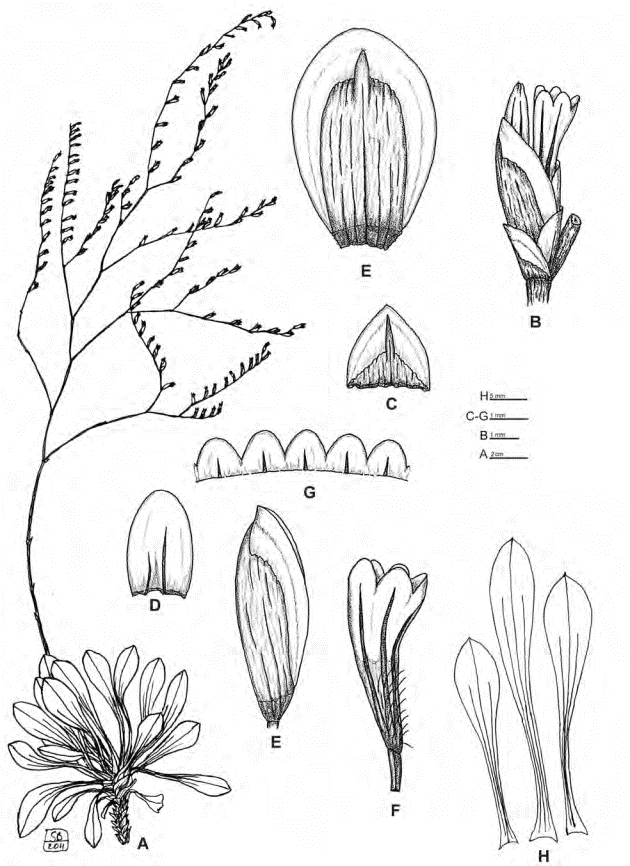LIMONIUM HIERAPETRAE
1. Limonium hierapetrae Rechinger fil. (1943b: 104) (Fig. 41)
Type (lectotype, designated here):-GREECE. Crete: Creta: Distr. Hierapetra: In litore arenoso a porto Hierapetra occidentem versus, 18 May 1942, Rechinger 13080 (W!, isolectotypes G!, M!).
Description:-Plant perennial, glabrous, forming a sub-shrub 30-80 cm tall, with several erect to ascending stems and a robust tap-root. Caudices 3-15 cm long, branched, densely spirally leafy in the upper third, living leaves in rosettes at apices. Leaves fleshy, pale green, flat, smooth, 35-120 mm long and 9-18 mm broad, oblong-lanceolate to oblong-spathulate, apex obtuse to rounded, sometimes shortly mucronate, retuse, 1 central nerve with 2 lateral nerves at least on large leaves, gradually tapering into the petiole. Stems green, 25-75 cm long, slightly flexuous, rugose, branching begins above the lower third of the stems. Inflorescence obtrullate in outline. Sterile branches absent or 1-4 per stem, 10-35 mm long, straight, undivided. Fertile branches 10-30 cm long, slightly flexuous, straight to slightly curved, directed obliquely upwards, forming branching angles of 35°- 50°, in the upper half branched. Spikes 30-120 mm long, straight to slightly curved, directed obliquely upwards. Spikelets 6.5-7.3 mm long, composed of 1-2 flowers, arranged very remotely biseriately with 1-4 per 2 cm. Outer bract 2.0-2.5 mm long and 2.1-2.3 mm broad, triangular-ovate, acute; bract margin broadly membranous; central part slightly fleshy, acuminate. Middle bract membranous, 2.4-3.0 mm long and 1.6-1.9 mm broad, oblong-elliptic, rounded. Inner bract (5.0-) 5.4-6.0 mm long and (3.8-)4.0-4.3 mm broad, oblong-obovate, rounded; bract margin broadly membranous; central part fleshy, 4.0-4.6 mm long and 2.1-2.5 mm broad, oblong to oblong-obovate, acuminate, forming a triangular tip, 0.7-0.9 mm long, not reaching the upper margin. Calyx 5.0-5.5 mm long, exceeding the inner bract by 1.3-1.5 mm; calyx tube unilaterally sparsely to densely long hairy, with 5 ribs ending above the base of lobes; calyx lobes ca. 0.8 × 1.2 mm, broadly semi-elliptic. Corolla blue-lilac.
Chromosome number:-2n = 43 (Artelari 1989c).
Distribution:-Confined to southeast Crete, around Ierapetra (Fig. 92G).
Habitat:-Calcareous and marly rocky coast.
Taxonomic remarks:-L. hierapetrae is similar to L. cornarianum and L. chrisianum, but it differs from both by having broader leaves, and longer and broader inner bracts. From L. chrisianum it differs by having longer spikelets, longer and broader inner bracts and longer calyces.
Type (lectotype, designated here):-GREECE. Crete: Creta: Distr. Hierapetra: In litore arenoso a porto Hierapetra occidentem versus, 18 May 1942, Rechinger 13080 (W!, isolectotypes G!, M!).
Description:-Plant perennial, glabrous, forming a sub-shrub 30-80 cm tall, with several erect to ascending stems and a robust tap-root. Caudices 3-15 cm long, branched, densely spirally leafy in the upper third, living leaves in rosettes at apices. Leaves fleshy, pale green, flat, smooth, 35-120 mm long and 9-18 mm broad, oblong-lanceolate to oblong-spathulate, apex obtuse to rounded, sometimes shortly mucronate, retuse, 1 central nerve with 2 lateral nerves at least on large leaves, gradually tapering into the petiole. Stems green, 25-75 cm long, slightly flexuous, rugose, branching begins above the lower third of the stems. Inflorescence obtrullate in outline. Sterile branches absent or 1-4 per stem, 10-35 mm long, straight, undivided. Fertile branches 10-30 cm long, slightly flexuous, straight to slightly curved, directed obliquely upwards, forming branching angles of 35°- 50°, in the upper half branched. Spikes 30-120 mm long, straight to slightly curved, directed obliquely upwards. Spikelets 6.5-7.3 mm long, composed of 1-2 flowers, arranged very remotely biseriately with 1-4 per 2 cm. Outer bract 2.0-2.5 mm long and 2.1-2.3 mm broad, triangular-ovate, acute; bract margin broadly membranous; central part slightly fleshy, acuminate. Middle bract membranous, 2.4-3.0 mm long and 1.6-1.9 mm broad, oblong-elliptic, rounded. Inner bract (5.0-) 5.4-6.0 mm long and (3.8-)4.0-4.3 mm broad, oblong-obovate, rounded; bract margin broadly membranous; central part fleshy, 4.0-4.6 mm long and 2.1-2.5 mm broad, oblong to oblong-obovate, acuminate, forming a triangular tip, 0.7-0.9 mm long, not reaching the upper margin. Calyx 5.0-5.5 mm long, exceeding the inner bract by 1.3-1.5 mm; calyx tube unilaterally sparsely to densely long hairy, with 5 ribs ending above the base of lobes; calyx lobes ca. 0.8 × 1.2 mm, broadly semi-elliptic. Corolla blue-lilac.
Chromosome number:-2n = 43 (Artelari 1989c).
Distribution:-Confined to southeast Crete, around Ierapetra (Fig. 92G).
Habitat:-Calcareous and marly rocky coast.
Taxonomic remarks:-L. hierapetrae is similar to L. cornarianum and L. chrisianum, but it differs from both by having broader leaves, and longer and broader inner bracts. From L. chrisianum it differs by having longer spikelets, longer and broader inner bracts and longer calyces.

FIGURE 41. Limonium hierapetrae Rechinger fil. A) Habit; B) Spikelet; C) Outer bract; D) Middle bract; E) Inner bract; F) Calyx; G) Calyx lobes; H) Leaves. (Habit and leaves drawn from “Creta, Myrtos, Brullo & Giusso s.n., CAT”, spikelet details from “K.H. Rechinger 13080, M”).